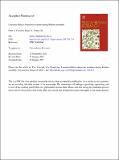Laurentia-Baltica-Amazonia relations during Rodinia assembly
Date
05/2017Metadata
Show full item recordAbstract
Laurentia, Baltica and Amazonia are key building blocks of the end Mesoproterozoic to early Neoproterozoic supercontinent Rodinia. Integration of available data sets enables development of a dynamic model for the Proterozoic interaction of these continental fragments in which Amazonian collision with Laurentia is linked to rifting and rotation of Baltica from Laurentia to collide with Amazonia’s northern margin. The geological record of the three blocks indicates a long history extending through the Paleoproterozoic and Mesoproterozoic involving continental growth onto Archean cratonic cores through convergent plate interaction and accretionary orogenesis. This history requires the existence of a long lived and probably large oceanic tract outboard of these continental fragments; the Mirovoi Ocean. Prior to 1265 Ma, Laurentia and Baltica formed a single tectonic plate. Sometime after this, but prior to 990 Ma, these blocks broke into two plates through opening of the triangular shaped Asgard Sea between northeast Laurentia and northern Baltica. After opening of the Asgard Sea the southern margin of Baltica lay at right-angles to east Laurentia. Thus, during final closure of the Mirovoi Ocean and collisional orogenesis, the western margin of Amazonia collided with the east Laurentian margin while the southern margin of Baltica collided with the northern margin of Amazonia. Laurentia, Baltica and Amazonia maintained this configuration until the final breakup of Rodinia with the opening of the Iapetus Ocean at the end of the Neoproterozoic.
Citation
Cawood , P A & Pisarevsky , S A 2017 , ' Laurentia-Baltica-Amazonia relations during Rodinia assembly ' , Precambrian Research , vol. 292 , pp. 386-397 . https://doi.org/10.1016/j.precamres.2017.01.031
Publication
Precambrian Research
Status
Peer reviewed
ISSN
0301-9268Type
Journal article
Description
PAC acknowledges support from the Australian Research Council grant FL160100168 and SAP was supported by Australian Research Council Australian Laureate Fellowship grant to Z.-X. Li.Collections
Items in the St Andrews Research Repository are protected by copyright, with all rights reserved, unless otherwise indicated.

